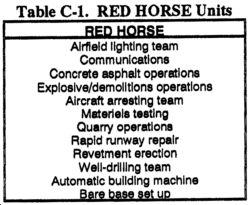Appendix C
Air Force Well Drilling
C-1. General. Air Force well-drilling teams are organized and assigned according to Air Force Instruction (AFI) 10-209. This publication outlines the organizational concepts and capabilities of the Rapid Engineer Deployable, Heavy Operational Repair Squadron (RED HORSE). This squadron provides the Air Force with a highly mobile, self-sufficient, rapidly deployable, civil-engineering, heavy construction and repair capability. The Air Force headquarters control RED HORSE. Well-drilling units are assigned as a special-skills team to an operational RED HORSE unit. The unit provides the logistical support necessary to complete the well-drilling mission and the administrative support well-drilling teams require (Table C-1).
These units are classified for deployment using the following categories:
a. RH-1. This is an air-transportable RED HORSE echelon composed of 16 people. An RH-1 team is ready for deployment 12 hours after notification. The squadron can perform advanced airfield surveys and site layout and can prepare for the orderly establishment and future development of a base of operations during contingencies.
b. RH-2. This is an air-transportable RED HORSE echelon composed of 93 people. An RH-2 team is ready for deployment 48 hours after notification. The squadron can erect base shelters and perform limited earthwork and light base development during the initial phase of contingencies. Light base development includes installing aircraft arresting systems, expedient airfield matting, and essential utility systems.
c. RH-3. This is a RED HORSE echelon composed of 295 people. An RH-3 team is ready for deployment six days after notification. Continental United States (CONUS)-based RH-3 personnel usually deploy by air to the TO where they can be joined with pre-positioned RH-3 equipment. CONUS-based RH-3 equipment usually moves overland to the TO. However, most RH-3 equipment is air-transportable on a C-5. With equipment, an RH-team is capable of performing heavy repair, runway repair, facility hardening, and airfield expansion, to include erecting relocatable facilities to support contingency operations.
C-2. Organization and Scope. Well-drilling teams are required to develop and provide adequate water resources for deployed forces.
a. Capabilities. The well drilling teams should be able to do the following:
- Disassemble, transport, and reassemble the drilling rig.
- Set up the well drilling rig and support equipment.
- Drill a 1,500-foot, 6-inch diameter well.
- Drill with mud, air, and foam circulation.
- Drill with down-the-hole hammer.
- Drill in sand, soil, clay, rock, or other geological formations.
- Perform operator's service checks and maintenance.
- Develop the well for connecting and interfacing with storage facilities and water-distribution systems.
b. Requirements. The hazards and risks associated with water-well drilling require the highest standards of training, proficiency, and safety. The following publications have specific responsibilities that apply to water-well operations:
- AFI 10-209.
- AFI 91-301.
- AFI 91-202.
- TA 429.
- Operations, maintenance, and repair manual for the assigned well-drilling rig.
- Repair parts manual.
c. Team Composition. A water-well-drilling team will be composed of a minimum of 12 trained personnel. The team must provide a four-man, 8-hour shift, 24-hour drilling operation. Teams should be primarily 3E2X1 (construction equipment) personnel in grades E3 through E8. However, other Air Force Specialty Codes (AFSCs) should be considered, such as 3E4X1 (utilities system specialist). The team must consist of 8 RH-2 and 4 RH-3 personnel (Table C-2). The officer in charge or noncommissioned officer in charge of the RH-2 or RH-3 team has the responsibility for well drilling. The 12-man team should be broken down to 3 four-man teams. Special positions and duties are as follows:
- Tool pusher (supervisor). Outlines the drilling program and sees that it is carried out.
- Driller. Operates the drilling rig.
- Derrick hand. Works in the mast, racks the steel, and so forth.
- Floor hand. Makes and breaks the connections, cares for all tools and equipment. Both floor and derrick hands carry out the mud program.
d. Publications and Documentation. In addition to the publications listed in C-2b, each squadron will maintain, at a minimum, the following standard documentation and publication files:
- TM 5-545.
- Ground Water And Wells (third edition).
- Ground Water Hydrology.
- Water Well Handbook.
- Drilling Mud Data Book.
- Engineers Handbook.
- Percussion of Drilling Equipment Operation and Maintenance Manual. Catalog #500-2.
e. Equipment. The equipment in the RED HORSE units is not standardized and varies in make and model.
|
NEWSLETTER
|
| Join the GlobalSecurity.org mailing list |
|
|
|



